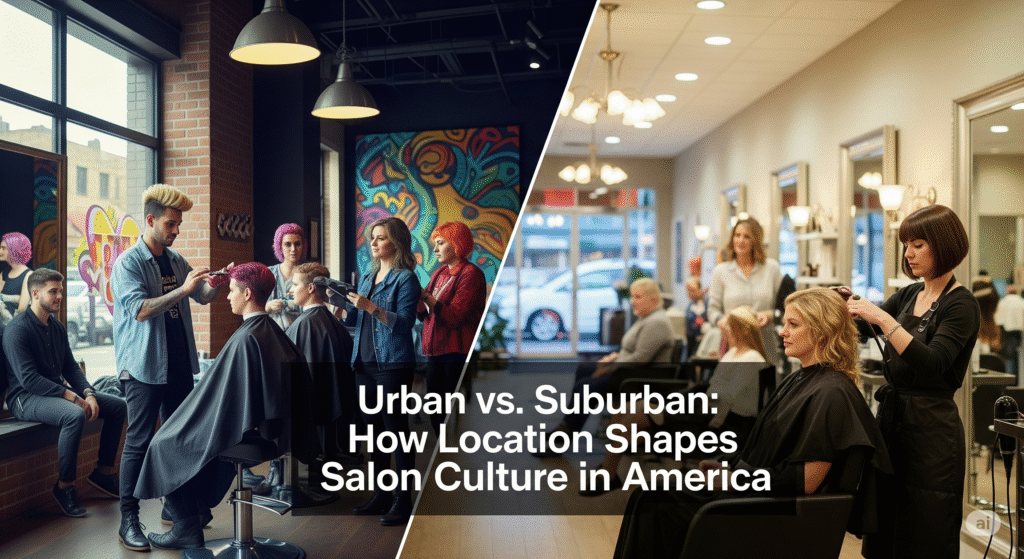Urban vs. Suburban: How Location Shapes Salon Culture in America

Content
The salon industry in America isn’t just about haircuts and highlights—it’s a fascinating reflection of American culture itself. Step into a salon in Manhattan’s Upper East Side and then into one in suburban Phoenix, and you’ll find yourself in two completely different worlds, each shaped by the unique rhythms, values, and lifestyles of their respective communities.
The Urban Pulse: High-Energy Hubs of Diversity
Urban salons operate at the speed of city life. In places like New York, Chicago, or San Francisco, these establishments often double as social media backdrops and networking hubs. The clientele is typically more diverse—ethnically, professionally, and stylistically—with clients ranging from Wall Street executives to creative professionals to influencers seeking the perfect post-salon selfie.
The Business Approach
Urban salons often embrace a high-volume, high-turnover model. Time is money in the city, and appointments may be precisely timed to the minute. Walk-ins are more common, and the pace can be frenetic. Stylists often specialize in cutting-edge techniques and trend-forward styles, charging premium prices that reflect the urban cost of doing business.
The Social Dynamic
City salons serve as community gathering spaces in a more transient environment. Regular clients often develop strong relationships with their stylists, who become confidants and advisors in a city where personal connections can be harder to maintain. These salons may also reflect the city’s diversity through their staff and client base, creating multicultural microcosms that mirror their neighborhoods.
Suburban Serenity: Community-Centered Comfort
Step into suburban America’s salons—from the cul-de-sacs of Texas to the planned communities of Colorado—and you’ll notice an entirely different atmosphere. These spaces often prioritize relationship-building over rapid turnover, with stylists who remember not just how you like your hair cut, but also how your kids’ soccer season is going.
The Neighborhood Feel
Suburban salons function as true community pillars. Many clients have been going to the same stylist for years, sometimes decades. Appointments are often made weeks in advance, and rescheduling requires a phone call to a familiar voice that probably knows your family’s schedule by heart. The pace is more relaxed, allowing for longer conversations and the kind of personal attention that’s harder to find in busier environments.
The Business Model
These salons often operate on a more traditional appointment-based system with emphasis on client retention over acquisition. Stylists may offer a broader range of services, from basic cuts to special occasion styling, and pricing tends to reflect the local market’s middle-class demographics. The relationship between client and stylist is often more personal and long-term.
Cultural Divides: Style, Service, and Expectations
The location divide extends beyond business models to fundamental differences in salon culture and client expectations.
Urban: Innovation and Edge
City salons are often early adopters of new techniques and technologies. From balayage to keratin treatments to Instagram-worthy color combinations, urban clients expect cutting-edge services and styles. The competition is fierce, and salons must constantly innovate to maintain their edge.
Suburban: Reliability and Familiarity
Suburban clients typically value consistency and reliability over novelty. They want their stylist to remember their preferences, arrive on time, and deliver predictable results. The emphasis is on maintaining appearance rather than dramatic transformations.
The Great Convergence
However, the digital age is blurring these distinctions. Social media has made urban trends more accessible to suburban clients, while urban salons have begun to recognize the value of building deeper client relationships. Many successful salons now blend elements of both cultures, offering the innovation and efficiency of urban services with the personal touch of suburban hospitality.
Technology’s Role
Online booking systems, social media marketing, and digital portfolios have created common ground between urban and suburban approaches. Even the most traditional suburban salon now maintains an Instagram presence, while urban salons have embraced client relationship management software to track preferences and build loyalty.
What This Means for the Industry
Understanding these cultural differences is crucial for salon owners, stylists, and industry professionals. An urban stylist moving to a suburban market needs to adjust their communication style, pricing strategy, and pace of service. Conversely, suburban salon owners looking to expand may need to learn the fast-paced, trend-focused approach that urban customers expect.
The beauty industry’s future likely lies in recognizing that both approaches have merit. Urban efficiency and innovation can benefit suburban clients seeking convenience, while suburban relationship-building can help urban salons stand out in crowded markets.
As America continues to evolve, with urbanization increasing while some families seek suburban lifestyles, salon culture will continue adapting to serve these diverse communities. The smartest operators will learn to read their location’s cultural cues while maintaining the core values that make great salons successful anywhere: skilled service, genuine care for clients, and an understanding that a haircut is never just about hair—it’s about how we present ourselves to the world.
Whether in a downtown high-rise or a strip mall along the suburbs, the best salons understand their communities and reflect back not just our desired hairstyles, but our values, aspirations, and sense of belonging in the American landscape.
